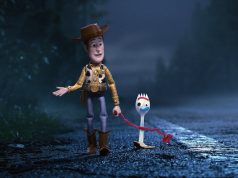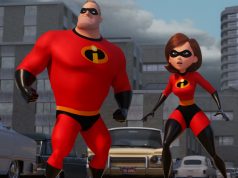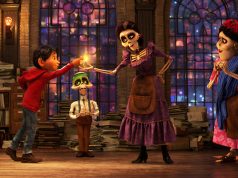When the Pixar wizards are at their best, they create films that are complex and thoughtful yet also, magically, hilarious and kid-friendly. We’ve stopped being amazed at how deftly they weave mature ideas into their candy-colored fantasies, simply because it keeps on happening, film after film.
Or so it seemed. The last few (“Cars 2,” “Brave,” “Monsters University”) have been, to varying degrees, sub-Pixar in quality, lacking depth and ambition. But “Inside Out” is a giant, heartfelt leap back in the right direction. Set mostly inside the brain of an 11-year-old girl, where we see her thoughts and actions determined by characters representing her different emotions, the film is a conceptual near-masterpiece … except for the big chunk in the middle where it isn’t. On either side of that section, though (and even in some respects within it), are many poignant delights.
The girl, Riley (voiced by Kaitlyn Dias), has just moved from Minnesota to San Francisco with her parents (Diane Lane and Kyle MacLachlan). The three adore each other and share a love of hockey. But moving is stressful, going to a new school is scary, and Riley is at the age where one’s emotions start to become complicated and irrational anyway.
Inside her head, looking out through her eyes from the starship bridge of her brain, are the five major emotions that govern her: Joy (Amy Poehler), Sadness (Phyllis Smith), Fear (Bill Hader), Anger (Lewis Black), and Disgust (Mindy Kaling). (It’s indicated that we all have these same five characters in our minds, tailored to our personalities.) Color-coded for easy reference and with attitudes befitting their vocations, any of the five li’l brain sprites can step in when their services are required, but Joy is usually in the captain’s chair, because (therefore?) Riley is generally a happy little girl. Lately, though, Sadness has been behaving erratically, and when she touches happy, yellow memories (which are bowling ball-sized spheres that project a scene), they turn blue, like her. That’s never happened before. The five emotions don’t know what’s going on.
In her frantic efforts to get things back to normal, Joy ends up whooshing herself, Sadness, and some of Riley’s most crucial formative memories out of mission control and down into Riley’s subconscious. For Riley, this means she now only feels anger, fear, and disgust. For the story, it means now there’s a journey: Joy and Sadness have to get themselves and the core memories back to Riley’s consciousness.
This is where the film struggles conceptually. The obstacles in Joy and Sadness’ way are presented as physical barriers (narrow bridges, a maze of hugely tall memory-storage shelves), and the arbitrariness of these choices is an obstacle in itself. Why are THESE the obstacles? What’s the analog? Why are there obstacles at all?
The other elements of the film are rooted in reality: abstract concepts like emotions and memories represented by tangible things like tiny personages and different-colored balls. But here it’s murkier. If your emotions were accidentally whooshed out of your consciousness and stranded in your subconscious — which, by the way, what does that even mean? — what would prevent them from coming back? Why are the shortcuts shortcuts? When they miss the Train of Thought (the one sturdy metaphor employed in this part of the story), why can’t they just wait for the next one? When Joy gets stuck in the supposedly inescapable pit of permanently erased memories, how does reusing an old daydream of Riley’s get her out?
The first section of the movie, at headquarters, is a marvel of carefully laid out metaphors that bring the intangible ideas to life. But in this second section, the rules of the universe are random and capricious, and it’s hard to feel invested. I just kept waiting, somewhat impatiently, for Joy and Sadness to get back so the story could continue.
There is a lot to enjoy in the subconscious, though, including Riley’s old imaginary friend Bing Bong (Richard Kind), who’s like a sad clown wandering the rows of stored memories. We also meet the mischievous pair of workers who throw out unneeded memories and will sometimes send an old commercial jingle up into the forefront of Riley’s mind, just to mess with her. We get to visit Riley’s dream production studios. Joy and Sadness are a funny duo, perfectly cast, and it’s oddly moving to see Joy come to realize that sometimes Sadness is the right emotion for the job.
Out in the real world, Riley is out-of-sorts and moody, and homesick for Minnesota. Your heart breaks seeing the poor girl go through tough times — a testament to director Pete Docter (“Monsters Inc.,” “Up”) and his team’s skill at conveying relatable, flesh-and-blood characters through computer cartoons. The stakes are small in scale — a little girl’s happiness, not life or death — but they feel personal, even intimate. The film is emotionally raw and deeply felt, filled with beautiful observations about how our feelings shape us.
It’s also very funny, unsurprisingly, when it’s not making you cry. The screenplay (credited to Docter, Josh Cooley, and Meg LeFauvre) gets some mileage out of showing glimpses of other people’s brains, with two gags in particular that are brilliantly executed. There are terrifically sly jokes about the way our minds work. There is, of course, the cheerful mismatched-buddy comedy that’s been one of Pixar’s hallmark ever since “Toy Story.” It’s a singular piece of work, really, cut from the familiar Pixar cloth, yet different from anything they’ve tried before. I love most of it.
B+ (1 hr., 34 min.; )





